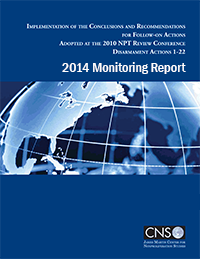Gaukhar Mukhatzhanova
April 23, 2014
 View the full 2014 NPT Action Plan Monitoring Report
View the full 2014 NPT Action Plan Monitoring Report
The ninth review cycle of the Treaty on the Non-Proliferation of Nuclear Weapons (NPT) is entering its final year, and states parties are gathering in New York on April 28-May 9, 2014 for the third Preparatory Committee (PrepCom) session. The central issue for the PrepCom and the rest of the review cycle is the implementation of the 2010 Action Plan, particularly its disarmament section. Progress in this area, however, remains very limited, and there is a growing gap between nuclear and non-nuclear weapon states on what constitutes satisfactory rate of implementation of disarmament commitments.
In 2011, the James Martin Center for Nonproliferation Studies (CNS) launched a project tracking the implementation of the 64-point Action Plan, which had been adopted by consensus at the 2010 NPT RevCon, to help assess whether progress is being made. Today, CNS released the third implementation report, covering the first 22 action items on nuclear disarmament as well as recommendations on the implementation of the 1995 Resolution on the establishment of a zone free of weapons of mass destruction (WMD) in the Middle East. The report is cumulative, covering the developments since the 2010 Review Conference, though highlighting, wherever possible, the period from April 2013 to April 2014.
Findings
Overall progress in implementing disarmament action items has not improved since the 2013 PrepCom. Although Russia and the United States continue to implement New START, consultations on follow-on measures had reached a dead end even before cooperation was suspended due to Russia’s intervention in Ukraine this spring. No unilateral arms reductions have been announced since October 2010 (United Kingdom). US President Barrack Obama announced in June 2013 that US deployed arsenal could be reduced by a third of New START-imposed limits, but linked potential new cuts to negotiations with Russia.
A particularly important area where progress has been lacking is the reduction of the role of nuclear weapons in military and security concepts, which should provide the overall context for the implementation of other concrete steps. The new presidential nuclear weapons employment guidance did not change the US doctrine, though it did direct the Department of Defense to look into ways to reduce the role of nuclear weapons in military planning. On the other hand, France and Russia both appear to be shifting attention away from nuclear disarmament by increasingly emphasizing general and complete disarmament in the context of Article VI of the NPT. In the meantime, all five nuclear weapon states are modernizing their arsenals, projecting continuous reliance on nuclear weapons for decades to come.
There appears to have been some progress in the consultations among the nuclear weapon states (or the “P5 Process”). The five states have now adopted a standard form for reporting on disarmament commitments. However, as their views on transparency continue to differ, individual reports the five states plan to submit to the 2014 PrepCom might vary significantly in the amount of information they contain. The main project that the nuclear weapon states are highlighting is the development of a glossary of key nuclear terms. Although having common terminology would be important for negotiating future disarmament agreements, the glossary, will not be released until 2015, falls significantly short of the non-nuclear weapon states’ expectation of substantive results.
Finally, the past two years have been marked by the rise of disarmament initiatives championed by the non-nuclear weapon states, particularly the discourse on the humanitarian impact of nuclear weapons. Although they have provoked negative reactions from the nuclear-weapon states, such initiatives help re-energize the debate and are likely to have a significant impact on the rest of the review cycle.
